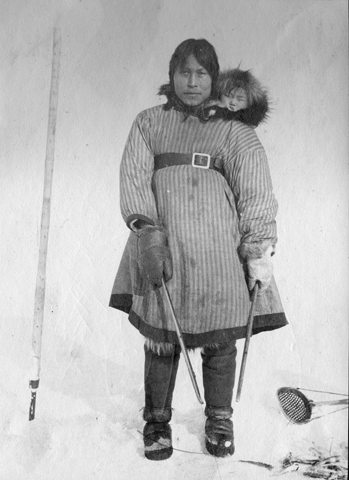
89.5.45, Ice-fishing for tomcod
Wales, Alaska, 1901
Photographer: Suzanne Bernardi
Lois Minium Collection
Why a special focus on the Artic, when the Maxwell Museum is in the sunny Southwest? It happens that the museum has outstanding collections from that part of the world. This learning path is based in part on a 2007–2009 exhibit, North by Southwest, at the museum.
Arctic artifacts went through centuries of technological refinement, until they were as specialized and sophisticated as human intelligence could make them. They also often reflect the irrepressible human urge to make beautiful things. The thumbnails on this page will take you to Arctic artifacts in the Maxwell's collections.

89.5.45, Ice-fishing for tomcod
Wales, Alaska, 1901
Photographer: Suzanne Bernardi
Lois Minium Collection
In the Arctic winter, proper clothing is essential. Without insulated, windproof gear, hypothermia can begin within minutes. Death soon follows. Clothing also protects against other environmental hazards, such as snow blindness and sunburn. If you're a permanent resident of the Arctic, you're interested in more than survival, of course. You also want comfort. It's not surprising that Arctic clothing designs (such as the fur-trimmed parkas shown above) are copied in "modern" winter clothing.
Artifacts that normally rot often survive in Arctic, thanks to the permanently frozen soil ("permafrost"). Even so, archaeologists working in Arctic sites typically find the "harder" parts of Arctic clothing, because the processes by which artifacts become deeply buried are usually slow and accidental. Today, due to global warming, many long-frozen items of prehistoric Arctic clothing are thawing out, are rotting in the damp soil, and are being lost. Click on the thumbnails to see items preserved at the museum.

89-5-18, Inupiaq woman fishing for tomcod
Wales, Alaska, 1901
Photographer: Suzanne Bernardi
Lois Minium Collection
To succeed as Arctic hunters, human beings needed a variety of tools. The photograph shown above is of a woman ice-fishing for tomcod. Besides her short double poles (one fishing pole in each hand), she has other specialized equipment close by. The spear-like tool is an antler-tipped ice pick for chopping a fishing hole. The netted scoop (strung with baleen) is used to clear the holes of floating ice. Success also depended on a thorough knowledge of the habits of game species. Tomcod fishing took place in the spring, a few hundred yards from shore. If you look carefully at the first photo on this page, you can see the village of Wales on the shore behind the wind screen.
The thumbnails below will take you to a number of items in the highly varied toolkit of Arctic hunters and fishers.
All content copyright © Maxwell Museum of Anthropology, University of New Mexico. High-resolution versions of photographs may be ordered from the Maxwell Museum's photo archives. Please make note of the catalogue number. For more information please visit the photo archives web page
Page last revised on June 10, 2011. Please report problems to toh@unm.edu